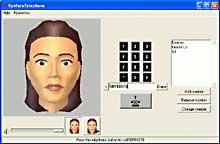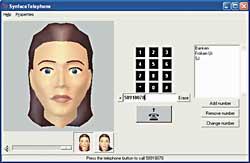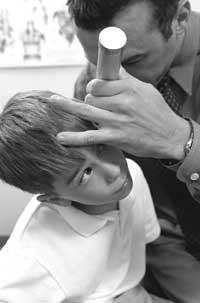Synface. New Deaf Phone
2004/11/14 Galarraga Aiestaran, Ana - Elhuyar Zientzia

A Swedish company, in collaboration with the European Union, has created the Synface software. You only need a phone and a computer, you connect and through Synface appears a face on the computer screen. The key is in the mouth of the face, on the lips: the movements of the lips of the face adjust to what the interlocutor has said. Thus, following the movements of the lips, the deafness can know what his friend says.
Progress is not despicable. In fact, previously there were channels for deaf people on the phone, but they were not very suitable. One of them is the videophone. This tool combines television with the phone and allows you to see the face of the interlocutor, so the deafness can read what she says on her friend's lips. However, this requires having such an instrument on both sides of the thread. In addition you need a broadband line, otherwise you do not see clearly the movements of the lips in the video.
Another way is the text. The text requires writing down what your friend said, making it impossible to have a normal conversation, as the need to write greatly slows down communication.
Listen and see all one

Synface lets you communicate naturally. It combines the technologies of linguistic knowledge with those of synthetic faces, listening and seeing sounds and images almost at once. In fact, he moves his lips 200 milliseconds behind the sound.
To achieve this, the computer program does not wait to know the whole word to move the image, but the movement occurs when the sound is known. In this way, word and movement occur almost at the same time and, in addition, allows its use without problems in different languages.
Synface therefore does not have a limited vocabulary, as it knows the sounds and serves any language. Small changes must be made to suit each language, but the basis is the same. The changes are due to the sounds: there are sounds that in some languages are not used in others and you have to introduce them in the program so that later you can know them. The first prototype can be used in English, Swedish, Dutch, and Italian and Finnish. Researchers hope that it can soon be used in any language.
For the benefit of many

The creation project of Synface has had the participation of numerous companies and institutions that will continue working until December. The first tests have already taken place in Britain and will soon be held in Sweden and Holland. 84% of test participants in Britain said they knew the words easily, while 74% said it was a great help to use the phone normally.
Inventors recognize that some of the users had trouble reading the lips of the digital face, but nevertheless the results are much better than with other systems. Therefore, researchers conclude that they are on the right track.
They think such a tool can help many people. Although they do not know how many people have difficulty hearing, there are studies that estimate that 80 million people can have this problem throughout Europe. For example, Sweden has 9 million inhabitants and about 800 thousand have difficulty hearing. Of them, 350 thousand need help to listen.
In addition, as the population ages, more and more people with hearing difficulties. On the other hand, there are experts who believe that Europeans begin to lose their hearing earlier and earlier, as the current life is very noisy and hurts their hearing. Therefore, they estimate that the number of people with hearing problems will increase over time.

Synface has also searched for other applications. For example, they think it would help to score in crowded, noisy places. For example, in a train station, what is said with words would also indicate on a screen, and those who have good ears would also benefit from seeing on one side the note the speaker is saying. They also believe that it can be integrated into laptops, PDAs and mobile phones. Everything to facilitate communication.
Published in 7K.

Gai honi buruzko eduki gehiago
Elhuyarrek garatutako teknologia





